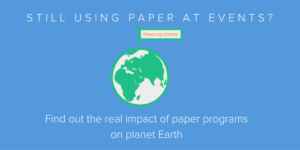Sponsors are critical to making an event achieve its maximum potential, plus it helps you forge good business relationships when sponsors get something out of it.
This article will discuss everything you need to know about making the best proposal for prospective sponsors so that your next event is a success.
Why Are Event Sponsors Important?
A competent event manager knows that an event could always use more budget, amenities, and popularity. The more of everything, the better.
However, resources are typically limited for most types of events. Unless the host is already a famous name, it won’t gain much attention from the people you want to invite without the proper promotion.
Sponsors can help resolve both the budget and promotion issues.
Having the right sponsors will provide additional resources that planners can tie into the event. Sponsors will typically provide financial backing, equipment, amenities, advertisement, or more.A well-chosen sponsor will also increase your popularity among your target audience. If your sponsor is well-known among your demographic, their name can add legitimacy to your event, increasing the number of attendees.
What is an Event Sponsorship Proposal?
But how do you reach these potential sponsors?
An event sponsorship proposal also called a “pitch deck,” is a proposition you send to companies, organizations, or entities to notify them of your sponsorship opportunities.
Event managers can persuade event sponsors or discuss how the event can help both sides.
Why Do You Need an Event Sponsorship Proposal?
Sponsorships are critical if you want to make potential sponsors know there are opportunities for them in your event. But are event sponsorship proposals the best way to reach them?
Maybe you think that you can reach them quickly enough through social media, instant messaging apps, or even email.
Maybe you know a few companies personally and think a phone call would do. Or perhaps you’re confident enough with the business understanding that you can just walk up to the front desk and ask for a meeting.
Those are all good points and not avenues to be discarded depending on the situation.
However, we’d still argue that a well-designed sponsorship proposal still adds value to what you’re trying to do. Here are the reasons why.
It Shows Effort and Dedication
Like a good handshake, a good event proposal shows that you can be a good partner and believe in the sponsorship enough to put the time and attention into making one.
The fact that you took the time to write, design, and send out a good event sponsorship template shows a high level of dedication which will undoubtedly make an excellent first impression on your sponsors.
If you do it well, your proposal’s excellent design and informative content will also set the standard for what sponsors can expect from your event.
It Reinforces Your Brand
Adding to the last point, an event sponsorship proposal also sets the tone for your event.
If your event is black tie and professional, a suitable proposal design will reinforce that. It will show potential sponsors what it’s all about without the time-consuming verbal communication it would have otherwise taken to get the point across.
Similarly, a fun, interactive, and laid-back gathering will also reflect on the pitch deck’s design.
From these impressions alone, sponsors will know what kind of event you have and whether or not it’s a suitable sponsorship opportunity. In other words, a good proposal streamlines the potential sponsor’s decision-making process.
It Acts as a Reference Material
Sponsorship proposals can be complicated affairs.
They’re not just simple docs or designs – they also deal with essential figures and numbers, which will most likely be the primary draw for most of your potential sponsors.
If you don’t make an event proposal, the finer details of your event could quickly go unnoticed, and figures could easily be jumbled.
Our brains aren’t equipped to deal with many details, and a proposal helps make remembering details much more manageable. This ease of access to critical information makes it easier to convince your sponsors that your event will benefit them.
It Serves as a Template for Future Proposals
You will want to make your systems more efficient as a competent event planner. Improving your system so that you won’t have to begin sponsorship proposals from scratch is an excellent way of ensuring that you won’t struggle in the next event you make.
An event sponsorship proposal template will save you precious hours and reduce the mental burden so that you can focus on other things that matter.
It Adds Value to Your Event
Last and perhaps the main argument for utilizing event sponsorship proposals is because it adds additional value to your event.
Any event planning activity will seek to maximize the resources at their disposal, but if you want your event to truly excel, find ways to achieve impressive logistical feats beyond what you’re currently capable of. You can do that through excellent sponsorships.
Sponsors can add value to your event in three different ways:
- Finances and resources. The most concrete example of sponsors adding value to your event is providing an additional source for assets. These assets could be money, equipment, giveaways, or other perks.
- Credibility. Sponsors lend more notoriety to your event. Names carry influence, especially if they are popular within your target audience.
- Additional perks. Perks are other assets that sponsors bring to the table, but they are not as easily defined as money, equipment, objects, experience, or sponsored events. An example might be a sponsored product adjacent but not competitive to your service/product that you can also feature at your event.
These benefits can only be achieved if you craft an informative and persuasive document highlighting your event’s selling point.
Types of Event Sponsorships
Now that you understand the importance of a good sponsorship event, you might be itching to make your proposals.
However, before you can genuinely make use of sponsors, you first have to understand that different types of sponsorships are made to address different needs. These types are as follows:
- Financial. Sponsors that give direct financial assistance are called financial sponsors. This is one of the most straightforward arrangements from the point of view of the sponsors since they won’t have other responsibilities beyond the financial investment.
- In-kind. Rather than providing money directly, in-kind sponsors offer other resources, such as goods and services. Typical examples are venues, prizes, food, digital equipment, and more.
- Media. As the name suggests, these types of sponsors provide media coverage for your event. This coverage could also be in different forms, such as articles, social media, live-streaming, television, radio, etc.
- Promotional. Similar to media sponsors, promotional sponsorships are typically high-profile individuals such as celebrities and social media personalities. Influencer advertising is steadily gaining popularity because of its relative cost-effectiveness compared to traditional media.
- Scholarships. For paid events, you may find sponsors to cover ticket costs for students or under-represented members of your target audience. Some sponsors value the goodwill they get from this, and your event gains revenue and a more diverse set of attendees.
- Merchandise. These sponsors provide branded merchandise and giveaways for the event. It could range from simple things like lanyards and pens to something more valuable such as gift bags, depending on the scale of your event.
It’s also important to note that significant events have sponsorship levels that detail the benefits both parties provide. Levels will typically be composed of several hierarchical tiers, with more benefits promised to sponsors that do the most for the event.
Knowing the event sponsorships available to you makes it easier to connect your needs to specific sponsors that your event might need.
How to Create a Sponsorship Proposal
Sponsorships are critical in making a good event run smoothly, but all of that will be for naught if you don’t have a good proposal in your hands. Therefore, learning how to craft a proposal that will persuade event sponsors and help you achieve your goals is essential.
Capture Their Interest With an Engaging Cover
Your cover is the first thing potential sponsors will look at when they receive your sponsorship proposal. In other words, the first page can create a lasting impression.
If you give something unprofessional, they will see that from your cover. Those negative impressions will remain throughout your proposal – after all, who would want to invest in an event when they can’t even be bothered to make a good cover?
On the contrary, a beautifully designed cover will immediately capture their attention and ignite their imagination. Plus, this shows professionalism, which will reflect positively on your proposal.
Create Rapport by Explaining What You Do
Within the following pages of your sponsorship proposal, you should write a story that highlights what your event is all about. You need to artfully divulge every detail of your event in a way that is relevant to the people you’re sending them to.
This means talking about what the event will entail. These are information such as the following:
- What the event is all about
- How it will be run
- What the end goal is
- What impact it will have
- Who will benefit
It’s also often a good idea to give potential sponsors an outline of where they fit in, although the details of this will come later.
Highlight Opportunities by Giving Them the Accurate Analytics
Also called the sponsorship prospectus, this part is the business case for your event and should highlight all the relevant analytics.
It acts as a case study that organizations can look at to decide whether or not the conference, festival, or whatever activity you have in mind is a worthy investment, depending on their goals.
Analytics like the following are especially sought out:
- Success metrics of past events
- Attendee details (potential numbers, demographic, interest)
- Successes of past sponsors in your previous events
- How resources are allocated
- What concrete roles there will be for sponsors to fill
These types of numerical information should be presented tastefully, preferably in infographic form with easy-to-read fonts or some other equally aesthetically pleasing way.
Aside from analytics, other information such as testimonials and reviews about your past successful events are also welcome on this page, as they serve as social proof to persuade your sponsors.
Show Them How They Can Get On Board
Now that you’ve highlighted the opportunities present, you will need to define the right ways sponsors can avail of these potential benefits.
This part will detail precisely how you can utilize sponsors in the event, what they can contribute, and what they can get in return. In short, this part will detail the sponsorship packages that your event will have.
There are different ways that sponsorship options can be created.
When sponsorship packages are discussed, the standard hierarchical tier systems often come to mind (e.g. Gold, Silver, Bronze). Most events will have three levels of sponsorships, with advantages increasing depending on set contributions that the other parties can fulfill.
However, there are also other types of packages that can be explored, such as the following:
- Offering to sell specific benefits instead of tiered benefits.
- Selling other perks, such as visibility, rights to create mini stands, etc.
- Giving away free benefits to sponsors that match a certain amount of contribution.
Explain How They Can Get in Touch
Lastly, your sponsorship proposal should include the specific steps to follow if they want to avail of the opportunities you present. This means adding contact information, point persons, where to send questions, office location, and more.
How to Write a Cover Letter for Your Proposal
A cover letter is essential, especially if you’re cold-canvassing companies that you haven’t had any prior contact with yet. The document will serve as an introduction of sorts and get them into the right frame of mind to assess your proposal.
Writing a cover letter is easy, but writing a good one takes attention and practice. Here’s how you can write the perfect cover letter.
- Direct your letter to a name. Addressing your letter to” to whom it shall concern” is a sure way to tell people that you haven’t done your research. Conversely, having a name to address your letter gives the impression of professionalism and diligence.
- Be concise. Sponsorship proposals are a dime a dozen to companies, and the people reading your letter would probably instead do some other work. Be concise in what you want to accomplish with your cover letter; the persuasion happens on the proposal.
- Introduce yourself and why you’re writing. Your first paragraph should introduce yourself, your event, and why you’re writing to them in plain, no-nonsense terms.
- Give them a taste of what’s to come. Your next paragraphs should highlight the merits of your event and how it can help them without bogging them down with details. For example, you could let them know you plan to feature them in your mobile event app, so they have an incentive to work with you.
- Close with specific instructions on what to do next. Your last paragraph should tell them to read your proposal or contact you if they have additional questions.
Sending Your Sponsorship Proposal: Tips and Tricks
No matter how great your sponsorship proposal is, it won’t be helpful to anyone if no one sees it. Here are some tried and true strategies you can employ to ensure your proposal ends up in the right hands.
- Do your research. First, you have to know which companies you will send the proposal to in the first place. Identify key players within your field, industry, and demographics and pick the most suitable ones to carry your brand.
- Do even more research. Now that you have your pick of companies, you must dig deeper to write a name on your cover letter or sponsorship proposal. Send some emails, utilize business connections, and go through LinkedIn profiles to track them down.
- Send an email. Initiate contact with a simple email notifying them of your interest in getting their sponsorships. If you’re unsure who to talk to, ask them in your initial email to direct you to the correct contact person.
- Go to their office location. It’s often a good idea to show up in their physical office once or twice. Emails might get overlooked, but an appointment set with the office staff will usually be entertained unless they have an excellent reason not to.
- Set deadlines and follow up. Sponsorships tend to take the back burner when it comes to company decision-making, so they remind sponsors frequently. It’s up to you how and when you follow up, depending on your situation, but take care not to come off as pushy.
The previous sections gave you everything you need about event sponsorship proposals. To make your work easier, we include a proposal template that will cover the basics of what a good sponsorship proposal should look like.
Remember that you should still tailor-fit this proposal for sponsors you’re chasing after, but with this hope, that process will run much smoother.
Cover Letter
Dear [organization head name],
I am [your name], and I represent the [company name], the organization behind the [upcoming event name]. I am pleased to inform you that a mutually-beneficial sponsorship opportunity for our next event is awaiting your consideration.
The [event name] is a [explain your event]. As its second incarnation, this year’s event will improve upon the success of last year’s [last year’s event name] that garnered [number of attendees] and the support of [number of sponsors].
Attached are the details of this sponsorship opportunity, as well as how you can get on board.
If you have any questions or want to set a meeting, please direct them to [point person’s contact info]. We hope you will be with us in making this [event name] the best possible.
Sincerely,
[Your name]
Sponsorship Proposal Template
Page 1: Event introduction.
Page 2 – 3: Relevant figures.
- Success metrics of past events
- Attendee details
- Previews of event’s attendee numbers
- Demographic
- Interest profile
- Successes of sponsors in your previous events
- Number of individuals who interacted with sponsors
- Cumulative social media impact of the event to sponsor pages
- New clients gained by sponsors
- How resources will be allocated
- What concrete roles there will be for sponsors to fill
- Funds necessary to make the event a success
- Additional resources needed, etc.
Page 4 – 5: Sponsorship packages.
Tier 1: $500 in cash or in-kind contribution.
- Logo in all the publication materials (including your event app)
- Special mentions during the event
Tier 2: $1500 in cash or in-kind contribution
- Everything in Tier 1, plus the following:
- Special promotional tarps in select spots
- Stall rights in choice places in the venue
Tier 3: $2000 and above
- Everything in Tier 2, plus the following:
- Priority placement for promotional tarps in high-traffic areas
- Priority placement for stall rights in high-traffic areas
- Purchase availability of additional stall spots and tarp areas.
Page 6: Call to action.
Making a Great Event Sponsorship Proposal
Every successful events manager wants their event to have the best possible outcome, and that’s often made possible through the help of a few key sponsors.
But before they invest in you, you must highlight what you can offer in a good sponsorship proposal.
Fortunately, this article discussed everything you need to know to make a killer proposal. Now, you should be ready to tackle the big event that your career rides on.
How can Yapp help?
- Increased Visibility: Event apps built through Yapp give sponsors added visibility through digital profiles and more opportunities to connect with attendees.
- Connect with Attendees: Sponsors can use the app to connect with attendees before, during, and after the event. This helps them build relationships and connections that could lead to future business opportunities.
- Targeted Advertising: Sponsors can use targeted advertising within the event app to reach the right audience at the right time. This helps them to get the most out of their investment in an event.
You can do all of that by building your event app with Yapp. Yapp helps you create a mobile app for your event with all the features you need to ensure that everything runs smoothly.
Try out Yapp’s free trial now!











